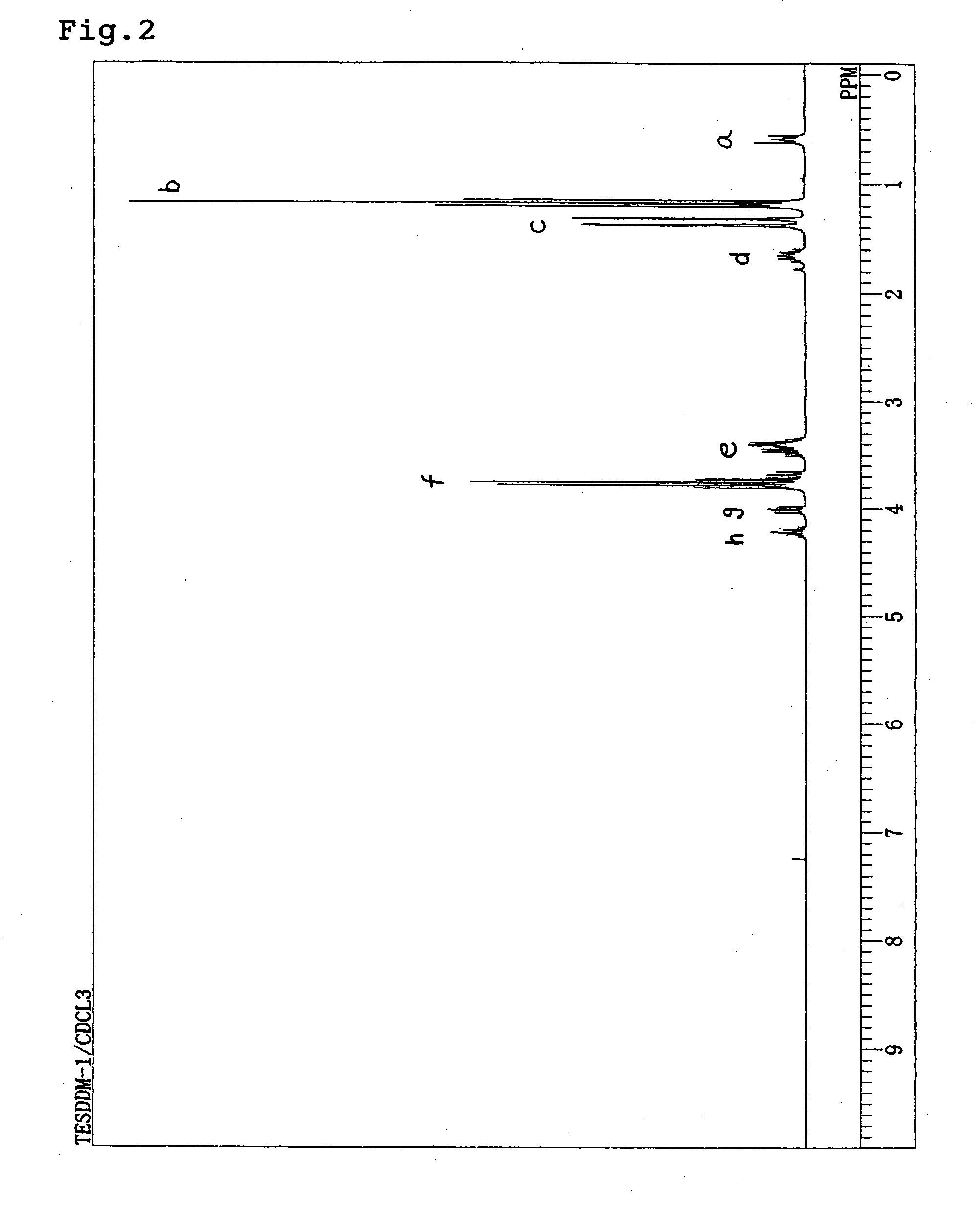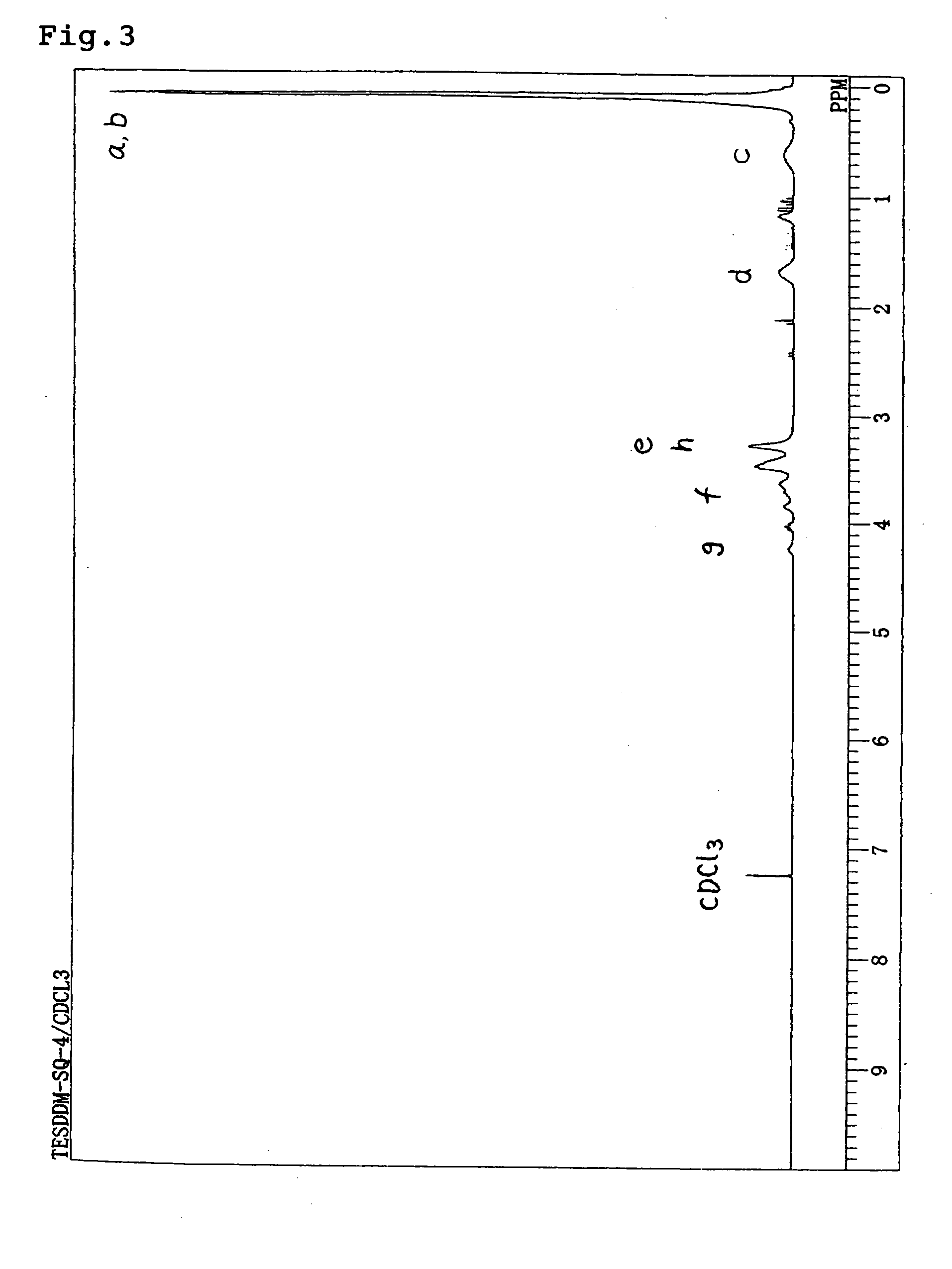Novel organosilicon compound, organosilicon resin having diol, and processes for producing these
a technology of organosilicon resin and organosilicon compound, which is applied in the direction of organic compounds, chemistry apparatus and processes, group 4/14 element organic compounds, etc., can solve the problems of difficult removal of remaining ingredients, difficult to accurately control the amount of diol to be introduced, and difficult to refine the organosilicon resin. , to achieve the effect of stable and stable composition, without time-course chang
- Summary
- Abstract
- Description
- Claims
- Application Information
AI Technical Summary
Benefits of technology
Problems solved by technology
Method used
Image
Examples
synthesis example 1
[0048] Sodium hydride (10 g: (60% in oil), 250 mmol) was charged into a reaction vessel provided with a condenser, a dropping funnel and a magnetic stirrer. And the sodium hydride was washed with dry hexane. Dimethylformamide (100 mL) was charged into a reaction system and cooled to 0° C. in an ice bath. DDM (30 g, 227 mmol) incorporated into the dropping funnel was dropped slowly. After dropping, stirring is conducted for one hour at room temperature and allyl bromide (30 g, 250 mmol) was slowly added. After the reaction was completed, water (50 mL) and diisopropyl ether (50 mL) were added to wash an organic layer. Anhydrous magnesium sulfate was used for drying and then a transparent and colorless liquid is obtained by distillation under reduced pressure [obtained amount: 21 g, 54%, boiling point: 98-99° C. (at 2,670 Pa)].
[0049] When 1H-NMR measurement at 270 MHz was performed for this colorless and transparent liquid, the spectrum shown in FIG. 1 was obtained. The d values and i...
embodiment 1
[0051] DDMAL (20.5 g, 119 mmol) obtained in Synthesis Example 1 was charged into and stirred in a reaction vessel provided with a condenser, a dropping funnel and a magnetic stirrer. Triethoxysilane (21.5 g, 131 mmol) was incorporated into the dropping funnel and 3.8 mL thereof was added into a reaction system. Temperature of an oil bath was set at 80° C. and when the internal temperature exceeded 70° C., a 0.1M Pt-dvds xylene solution (0.02 mL, 0.002 mmol) was placed in to initiate a reaction. After the reaction was completed, a transparent and colorless liquid was obtained [obtained amount: 25 g, 63%, boiling point: 115-116° C. (at 130 Pa)].
[0052] When 1H-NMR measurement at 270 MHz was performed for this colorless and transparent liquid, the spectrum shown in FIG. 2 was obtained. The d values and identifiers thereof were as shown in Table 2. The compound thus obtained was confirmed as having the structure (TESDDM) shown below.
TABLE 2Measurement methodδ (ppm)Assignment1H—NMR0.6a...
embodiment 2 (
Synthesis of Organosilicon Resin)
[0054] TESDDM (4.04 g, 12 mmol) obtained in Embodiment 1, methyltriethoxysilane (7.86 g, 44.1 mmol), hexamethyldisiloxane (1.95 g, 12 mmol) and isopropyl alcohol (9.9 g) were charged into and stirred in a reaction vessel provided with a dropping funnel and a magnetic stirrer. An aqueous solution of 1.5 wt % hydrochloric acid (3.74 g) was incorporated into the dropping funnel and slowly dropped. After dropping, stirring was conducted for 1.5 hours at room temperature. Diisopropyl ether (20 g) was added and then anhydrous magnesium sulfate was added and dried for 2 hours. Subsequently the anhydrous magnesium sulfate was filtered and hexamethyldisilazane (3.87 g, 24 mmol) was added slowly while stirring. Stirring was conducted for 2 hours at room temperature, and the solvent is distilled away under reduced pressure. Then methylethylketone (20 g) and 1N-hydrochloric acid solution were added. After washing, and rinsing was repeated until the water layer b...
PUM
| Property | Measurement | Unit |
|---|---|---|
| carbon number | aaaaa | aaaaa |
| carbon number | aaaaa | aaaaa |
| carbon number | aaaaa | aaaaa |
Abstract
Description
Claims
Application Information
 Login to View More
Login to View More - R&D
- Intellectual Property
- Life Sciences
- Materials
- Tech Scout
- Unparalleled Data Quality
- Higher Quality Content
- 60% Fewer Hallucinations
Browse by: Latest US Patents, China's latest patents, Technical Efficacy Thesaurus, Application Domain, Technology Topic, Popular Technical Reports.
© 2025 PatSnap. All rights reserved.Legal|Privacy policy|Modern Slavery Act Transparency Statement|Sitemap|About US| Contact US: help@patsnap.com



